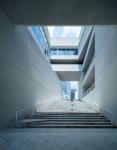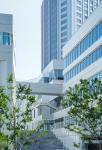Renovation of Guosheng Center: Regeneration Design of "Decomposition" and "Reconstruction"
Project brief – The city needs to be renovated, buildings will age, but memories and spaces will continue.
Guosheng Center is located opposite the Changfeng Park, and on the Internet, we can still find the news that the center was "The first Chinese project to win in the complex category in the Asia-Pacific region and enter the final global competition". However, the center is now closed. The closed, large volume commercial building with large depth has been proved unfit for further use by practice. Although the building is no longer in use, the city still needs to grow, that’s why we usher in this renovation and renewal.
The transformation of traditional shopping mall mode to office - urban renovation: committed to the revival of places
Start with problem solving - an attempt to reconstruct the site
The four-story, about 30,000-square-meter Guosheng Life Plaza was completed in 2010 and adopted a traditional SHOPPINGMALL model. The site has now been transformed into a site for cultural facilities and will be used mainly as an office and multi-purpose space in the future. Since it was once designed as a SHOPPINGMALL, its facade gave little consideration for lighting, and the inverted conical glass box on the corner also bring a sense of old fashion to the mall facade. The conflict between commercial function and office function is difficult to solve: too large store depth, poor lighting, too large volume, and flow line are difficult to apply to functions other than commercial street. In addition to the functional transformation, the surrounding environment is also changing. The subway has completely changed the way people arrive, the corner square will become a new gathering place, and the site's role as a cultural and leisure space also requires a rethink of how to respond to the urban park opposite.
Design is the process of identifying problems and solving them, solving the above problems is regarded as a starting point, and space is used to realize the dialogue between the past and the present. Although this is not a historic site, it also hopes to create an open and new living environment in the process of renovation, and ultimately achieve the revival of the urban block.
"Block" designed for change - decompose history and reshape space
1 "Decomposition" and "Reconstruction"
The shops on the east and west sides of the original plane are about 30 to 50 meters deep and arranged on both sides of the cross-shaped atrium. Due to the comprehensive consideration of the original structure, the use of office space after renovation and lighting problems, the design creatively disassembles the entire building into four parts based on the original cross-shaped atrium. In this way, "one big building" becomes interconnected "four small buildings", the commercial vitality, the multi-functional format and the openness of the city are expressed in this design, creating a more dynamic and open urban space of Shanghai for the whole new environment and the new future, and thus resolving the contradiction in functional use caused by the conversion of commercial space into office space.
The disassembled parts place the traffic conversion center in the middle, the lighting depth of all office spaces is no more than 15 meters, and some spaces can enjoy lighting on two or even three sides. After disassembling the entire building, the "independent" buildings still need to share space and have transportation links between them. Four corridors are also designed to connect the separated small buildings, and together with the external stairs, they connect the indoor and outdoor double traffic lines, so that people can smoothly and easily reach each space.
2 The endogenous block pattern presents both "interior" and " exterior " elements
After disassembling, an open block space is naturally formed. The space is both open and internal, and it also brings a unique element - the "interior" facade of the block. These interior facades, together with the block space, create rich spatial scenes that extend the sense of the outside to this point and immerse people in a unique sense of the interior space.
3 Reviving urban streetscape: interface and corner spaces
The urban interface along the Daduhe Road extends to East Yunling Road, where a new corner square is formed by combining with the subway. The square is reconstructed as an important transition for the integration of the project and the urban space. This urban interface makes the building to spread out laterally along Daduhe Road and gradually retreat layer by layer to the roof garden, allowing the building to naturally grow, blend in, and become an extension of the park.
It is hoped that this renovation can optimize the surrounding environment and integrate the urban space, so as to achieve harmony and coexistence with the urban public space, and regenerate a pleasant city corner for Shanghai.
2020
2023
Gross internal area : 40852.53 m-squared
Net internal area : 34111.86 m-squared
Lead Architects: SONG Zhaoqing
Project Manager: LI Sheng, REN Yemo
Design Team: ZHANG Runyang, WANG Chong, CHEN Fei, LIU Zhengrui, LIU Shenglin, WANG Yang, LI Jichen, YU Mingming
Landscape Design: Lacime Landscaping Design Co.,Ltd.
Construction Drawing Design: Shanghai Zhujing Architectural Design Co.
Curtain Wall Design:Jiangyin Huade Curtain Wall Design Co.
Architectural Photography: Zhang Qianxi











